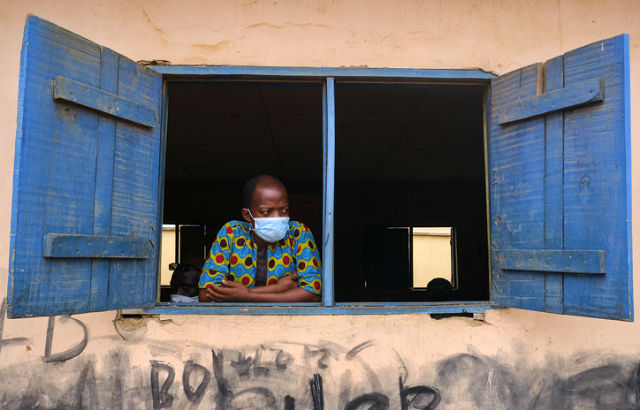Covid-19, lockdown and Africa
Professor David McCoy, Professor of Global Public Health at Queen Mary, examines why the number of Covid-related deaths in Sub-Saharan Africa has been less catastrophic than forecast, while highlighting some of the more serious indirect impacts of the virus.

A man looks out the window at a venue for the Lagos State Environmental Protection Agency (LASEPA) and the Lagos State Safety Commission Social Distancing Advocacy program at Ikorodu, Lagos.
Scientists are still trying to understand why the pattern of Covid-19 is so variable across the world. In Sub-Saharan Africa (SSA), although over 1.5 million cases have been reported as of October 10, earlier predictions that Covid-19 would prove catastrophic in SSA have thankfully been proven wrong. Presently, the number of reported deaths attributed to Covid19 in the whole continent is less than the reported figure for England alone.
As elsewhere, the number of reported cases and deaths is a function of the number of tests done and of the reliability and completeness of the reporting system. The rate of testing and the quality of information systems is hugely variable across the African continent and we do not have a particularly accurate description of the epidemic in many SSA countries. However, based on the experience of morgues and the number of hospitalisations of adults with severe respiratory disease, the pandemic does appear relatively benign compared to the experience here in the UK.
A younger population and a lower prevalence of obesity and other illnesses are partial explanations. A greater level of pre-existing immune protection is another likely partial explanation. One hypothesis is that BCG vaccinations which are provided in most SSA countries may confer some immunological protection against Covid-19.
Focusing on other effects
Unfortunately, the indirect impacts of Covid-19 may have been more damaging – possibly a case of the cure being worse than the disease. In particular, the collateral damage of so-called ‘lockdown measures’ has been significant.
This includes disruptions to health systems functioning, including vaccination programmes for children, as well as patients avoiding hospitals for fear of contracting Covid-19. The closure of schools, colleges, universities and businesses is another source of harm, particularly for the millions of households already living in poverty without robust social security and welfare systems. There have also been reports of food price increases attributed to lockdown.
Furthermore, while lockdown measures will reduce transmission in many settings, it is plausible that in the large and dense informal or semi-formal settlements of Africa’s big cities, such measures could have reduced physical distancing and increased transmission. In Accra for example, about 53 per cent of households live in a single room, while an even larger proportion relies on public toilets. There are also reports of over-crowded and poorly managed quarantine centres becoming hotspots of transmission.
The capacity of countries to mitigate the social and economic harms of lockdown is also more limited. South Africa, with its large economy and greater fiscal flexibility, was able to implement a social relief and economic support package worth about 10 per cent of its GDP. But most other African countries have little capacity to protect themselves from the pandemic’s economic shocks.
Although the weakness and fragility of the health, social and economic systems in many African countries is known, there has been relatively little attention focused on monitoring the design, implementation and impact of lockdown measures in Africa. There has also been little scientific discussion about how we should define ‘lockdown’, despite the term having become ubiquitous. Indeed, the WHO’s reference to ‘so-called lockdown measures’ indicates the absence of a clear and universally-accepted definition of the term ‘lockdown’.
Defining a 'lockdown'
Last week, a paper published in BMJ Global Health by myself and colleagues from over ten other countries, went a small way towards rectifying this gap in the academic literature. The paper proposed a definition of ‘lockdown’ based on a two-by-two matrix that categorises different communicable disease measures according to whether they are compulsory or voluntary; and whether they are targeted at identifiable individuals or facilities, or applied indiscriminately to a general population or area.
Using this definition, the paper described the design, timing and implementation of lockdown measures in Ghana, Nigeria, South Africa, Sierra Leone, Sudan, Tanzania, Uganda, Zambia and Zimbabwe. We found some commonalities in the implementation of lockdown in these countries, but also considerable variation in the design, timing and implementation of lockdown measures.
More research is needed, but our findings also indicated that little evidence of lockdown measures having any impact on the reported cases of Covid-19, raising questions about the appropriateness of lockdown in the SSA context.
Professor David McCoy is an experienced global public health generalist who has recently been providing commentary on the coronavirus pandemic to outlets such as The Guardian and Newsnight.
Related items
For media information, contact:
Pete BiggsInternational Communications Manager
email: p.biggs@qmul.ac.uk